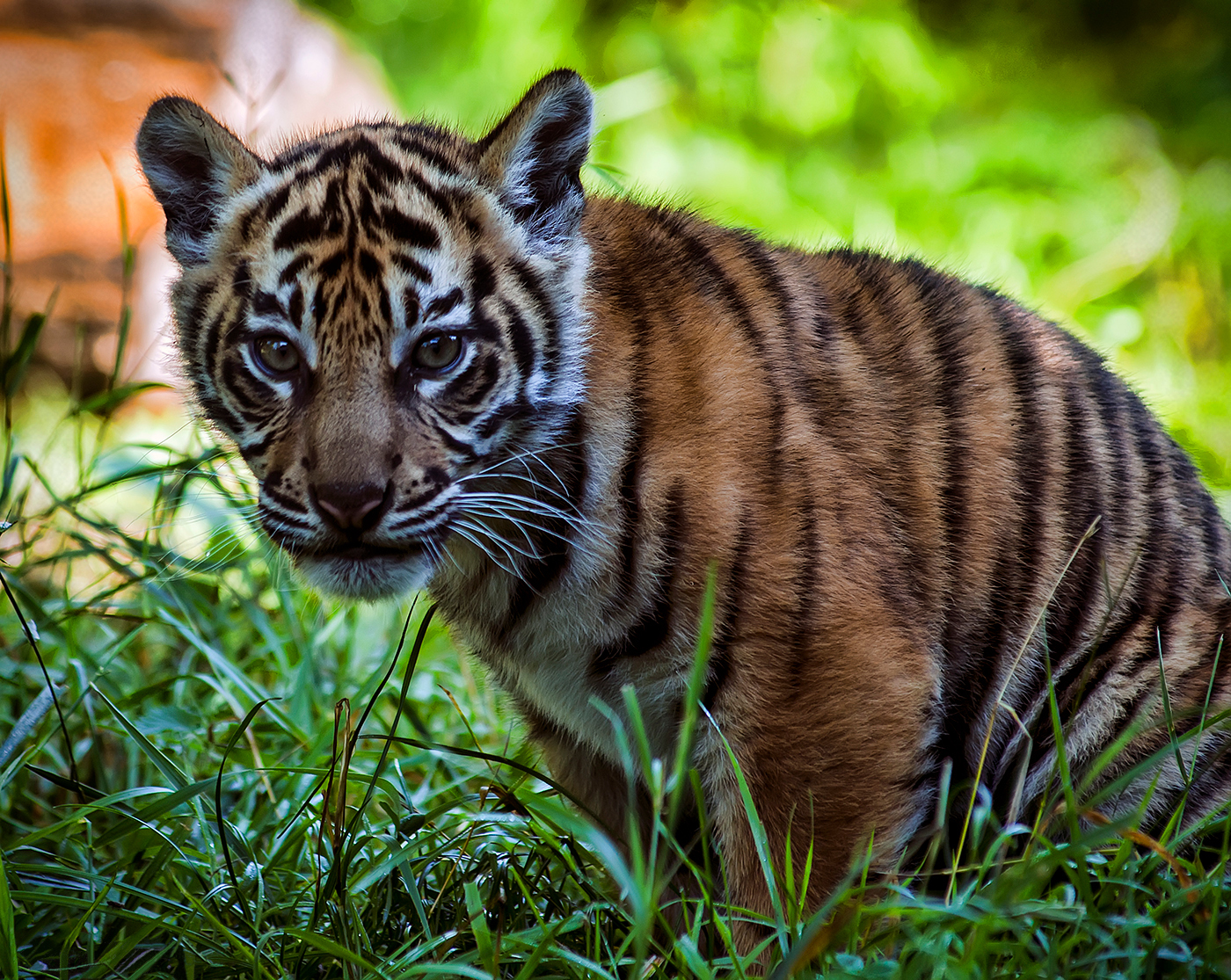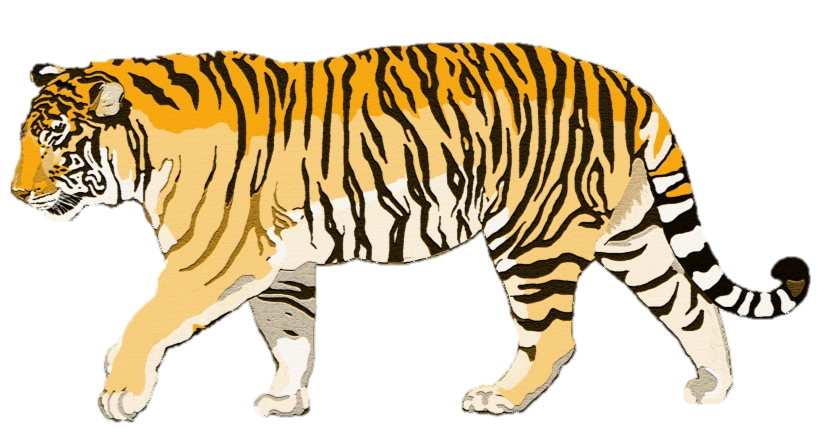TIGER

- Tigers are currently listed as endangered.
- There are only around 3,900 tigers existing in the wild compared to 1,00,000 tigers at the start of 20th century.
- Tigers love water and are fantastic swimmers.
- Tigers are so powerful, they can take down prey weighing up to five times their own body weight.
- Tigers are solitary animals. They almost always travel alone. Individual tigers roam across large areas of land, which are called thehome ranges.
Body
- They weigh about 100–300 kg and grow 4–10 feet long.
- They have super soft pads on their feet, so they can move soundlessly when stalking prey.
- A tiger’s tail is around 3 feet in length. It is mainly used for balance. A tiger shows it is relaxed by letting its tail hang loosely. If a tiger is feeling aggressive, it will rapidly move its tail from side to side or hold it low.
- Tiger roars are powerful and can travel long distances (they can be heard as far as 3 km away).
- Cubs are born blind and do not open their eyes until about 6–14 days after birth.
- Tigers have six times better vision at night than humans do.
- The average tiger has more than 100 stripes. No two tigers have the same stripe pattern.
Food
- A tiger can consume up to 40 kg of meat at one time!
Habitat
- Tigers are found in amazingly diverse habitats: tropical rain forests, evergreen forests, temperate forests, mangrove swamps, grasslands, and savannas.
- There are currently only 13 countries that tigers range across: Bangladesh, Bhutan, Cambodia, China, India, Indonesia, Lao PDR, Malaysia, Myanmar, Nepal, Russia, Thailand, and Vietnam.
Species
There are two recognized subspecies of tiger:
- The continental
- The Sunda (island)
All island tigers are found only in Sumatra, with tigers in Java and Bali now extinct. The continental tigers currently include the Bengal, Malayan, Indochinese, and Amur (Siberian) tiger populations, while the Caspian tiger is extinct in the wild. The South China tiger is believed to be functionally extinct.
Why Tigers Matter
Keep nature in balance, for the good of all: Occupation for forest dwellers
Millions of people around the world depend on forests for hunting, gathering, small-scale agriculture, medicine, paper, wood, and other forest products.
As a large predator, the tiger plays a key role in maintaining healthy forest ecosystems. The tiger’s hunting activity helps keep the numbers of other animal populations under control, which in turn helps keep the land intact and other environmental factors in balance—like water and food availability.
Keeping these things steady and balanced is important to the well-being and health of humans as well as the animals who live in these areas—so that means by saving tigers, we are helping people too.
Protecting tiger territory protects many other animals.
To protect one tiger, we must conserve around 25,000 acres of forest. Just one tiger’s range is home to hundreds of other endangered animals and plants. So when we protect one tiger, we can save so much more than just that one animal.
They can help communities in need: Tourism
Tigers can directly help some of the world’s poorest communities. Where tigers exist, tourists go. And where tourists go, eco-friendly tourism projects can be created, providing sustainable livelihood opportunities for communities with few other alternatives for income.
They are living legends: Present in mythology texts
How often can you say that an animal found in myths and legends actually exists in the real world? This is the case for tigers. For centuries, they have captured our imaginations and inspired awe. If they were to go extinct, we would no longer be able to see this living legend in our world.
The Threats Tigers Face
Tigers require prey, protection, and room to roam in order to flourish, but certain human activities threaten their forest habitat and their ability to survive in the wild. Here are some of the human-generated threats they face:Habitat loss
Tigers require large areas to roam. As human populations grow, the forest areas where tigers roam are at greater risk of being wiped out or fragmented due to agriculture, timber, and development activities such as the building of roads and infrastructure. This can make it increasingly hard for the animals to move around and breed, which leads to decreased population growth. Tigers have lost 95% of their historic range due to deforestation, forest degradation, and forest fragmentation.
Poaching and illegal trade
Poaching is the biggest immediate threat to wild tiger populations. Every part of the tiger—from whisker to tail—is traded in illegal wildlife markets, mostly for use in traditional medicine.
Human-tiger conflict
People and tigers increasingly compete for space. As forests shrink due to human activity, prey gets scarce and tigers are forced to hunt domestic livestock, which many local communities depend on for their livelihood. As a result, tigers are often killed or captured in retaliation for livestock loss. This conflict threatens the world’s remaining wild tigers and poses a major problem for communities living in or near forests with tigers.
Climate change
Climate change could speed up tiger habitat loss even further. For instance, rising sea levels caused by climate change can lead to flooding and threaten to wipe out areas in the Sundarbans region of India and Bangladesh, along with the last remaining habitat of the tiger population there. Also, intense droughts in Southeast Asia could affect vulnerable and fragmented pockets of rain forest, leaving jungle-living tigers with nowhere to live. These severe and unpredictable climate change-related weather impacts can make it difficult for tigers to adapt and survive.
What Kids Can Do
Buy eco-friendly paper products
Tiger habitat is at risk of being destroyed when forests are cut down irresponsibly and converted to products such as tissue, toilet paper, and wooden items. We can help tigers by opting to buy 100% recycled paper and wood products.
Be aware of the illegal wildlife trade
Poaching and the illegal wildlife trade are a huge threat to the future of tigers and other endangered wildlife across the world. Never buy any products that come from tigers or endangered animals. Examples of these include tiger skins, jewelry made from claws and teeth, tiger whiskers, tiger bone wine, tiger meat, and any medicine that contains tiger derivatives.
Spread the word
Kids can talk to their parents and friends about what they have learned about tigers and ask them to do the things on this list, too!










Comments
Post a Comment